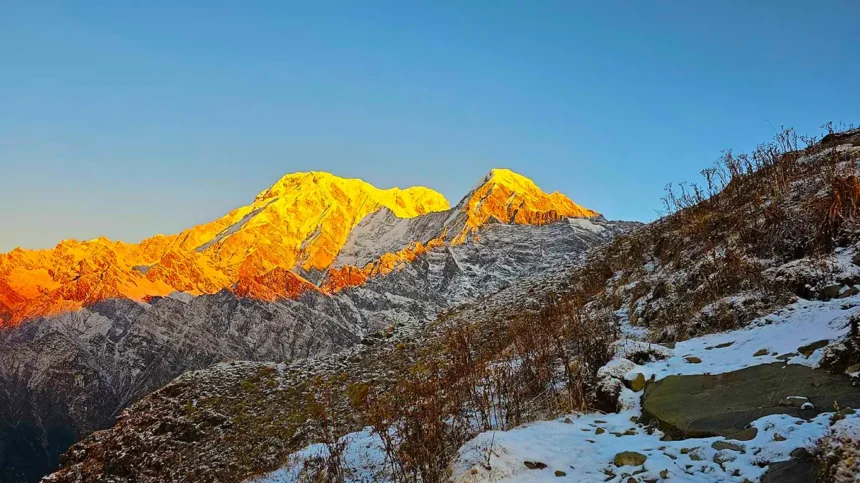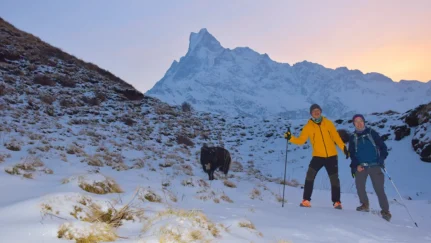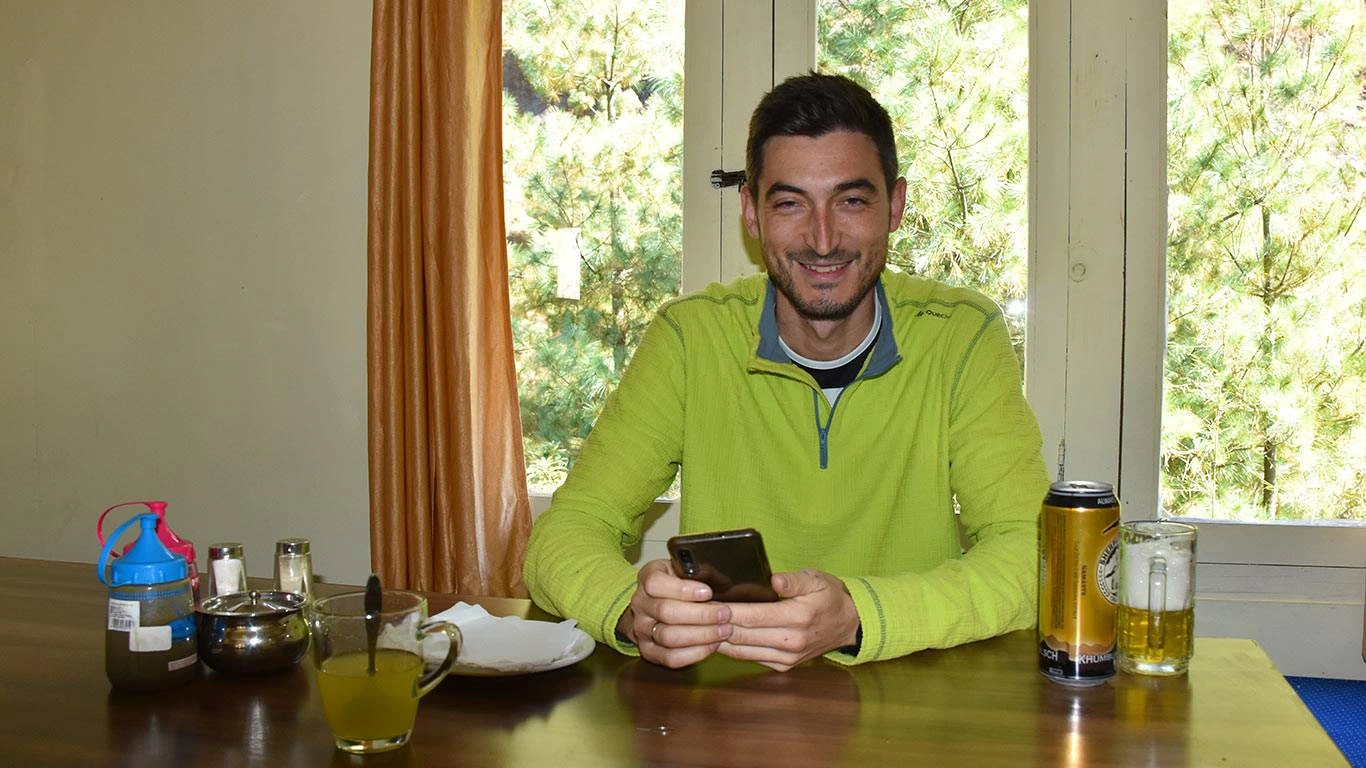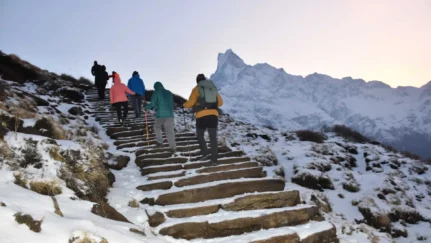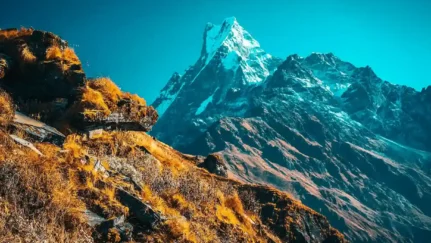If you’re dreaming of an adventure with amazing views, rich culture, and peace, the Mardi Himal Trek is perfect for you. Located in the Annapurna region of Nepal, this trek gives you stunning sights of the Annapurna mountain range, green forests, and terraced fields. It’s a favorite for those who want beauty without the big crowds of other popular treks. Whether you’re new to trekking or have lots of experience, Mardi Himal’s charm is hard to ignore.
But here’s the thing: planning this journey takes careful thought, especially when it comes to costs. Knowing the Mardi Himal Trek cost is important so you can enjoy the adventure without breaking the bank. From permits and transportation to where you’ll stay and what you’ll eat, there are several important things to budget for.
This guide will help you understand the main expenses of the Mardi Himal Trek. We’ll cover all the costs, whether you’re looking for a budget, mid-range, or luxury experience. By the end, you’ll know what to expect money-wise, so you can focus on enjoying your adventure with no surprises. Let’s dive in and start planning your unforgettable trek!
Costs of Mardi Himal Trek
Permits for the Mardi Himal Trek
Before you start your trek, you need to get two important permits:
- TIMS Card (Trekking Information Management System): This card helps keep track of trekkers for safety. It costs around $10 for solo trekkers and $5 for groups.
- ACAP (Annapurna Conservation Area Permit): This permit is needed to enter the Annapurna Conservation Area, a place full of beautiful landscapes and wildlife. It costs about $30 for foreigners and $10 for SAARC nationals (South Asian countries).
Together, expect to spend about $40 to $50 on permits, making sure your trek is safe and legal.
Transportation Costs to Mardi Himal Trek
Getting to the starting point of the Mardi Himal Trek involves a few transportation options:
Kathmandu to Pokhara:
- Bus: A budget-friendly option, costing around $7 to $10, with a travel time of 6 to 8 hours.
- Flight: A quicker option, taking about 30 minutes, with a price range of $100 to $130.
- Private Vehicle: For more comfort, you can hire a private car for about $80 to $120, depending on the vehicle.
Pokhara to Kande:
Kande is where the trek begins. You can take a local bus or shared jeep for $2 to $5.
Optional Helicopter Ride:
If you want a luxurious start, a helicopter from Pokhara to Kande can cost between $300 to $600.
Accommodation Costs
Accommodations on the Mardi Himal Trek, you’ll mostly stay in teahouses or lodges:
- Basic Rooms: These cost between $5 to $15 per night, usually with shared facilities.
- Private Rooms: For more privacy, rooms range from $20 to $40 per night, depending on where you are.
- Upgrades: At higher spots like Forest Camp or High Camp, you can find better lodges with prices from $30 to $60 per night if you want more comfort.
Food and Water
Food on the trek is simple but filling:
- Meals: Dishes like dal bhat (lentils and rice), noodles, and soups cost between $3 to $7 at lower altitudes. Higher up, meals can cost $7 to $12 due to the difficulty of transporting supplies.
- Drinking Water: Bottled water costs around $1 to $3 per liter, but using water purification tablets, which cost about $5 for a pack, is a cheaper option for the entire trek.
Guide and Porter Fees
Hiring a guide or porter can make your trek more enjoyable:
- Guide: Expect to pay $25 to $30 per day for a guide.
- Porter: Porters charge around $15 to $20 per day.
To save money, you can share a guide with other trekkers. Hiring local guides not only helps you learn more about the culture and nature, but it also supports the local community.
Other Costs
Don’t forget these extra costs:
- Wi-Fi and Charging: Some teahouses offer Wi-Fi and charging for $1 to $3 an hour.
- Hot Showers and Laundry: A hot shower might cost $2 to $5, and laundry services can range from $5 to $10.
- Tipping: It’s a good idea to tip guides and porters about 10% to 15% of the total cost as a thank you for their hard work.
By understanding these costs, you can better plan your budget and have an amazing time on the Mardi Himal Trek!
Mardi Himal Trek Budget Options
Budget-Friendly Mardi Himal Trek
If you want to trek Mardi Himal without spending a lot, here are some ways to keep it cheap:
Tips for Low-Cost Trekking:
- Travel in the off-season: Going during late autumn or early spring means fewer people and lower prices for rooms and transport.
- Travel with a group: Teaming up with other trekkers can help split the cost of guides, porters, and places to stay.
Staying in Cheaper Rooms:
Stay in basic teahouses that charge about $5 to $10 a night. They have what you need and let you experience local culture while saving money.
Eating Simple Meals:
Stick to local foods like Dal Bhat or noodle soups. These are filling and cheap, around $3 to $5 per meal. Avoiding Western food will also keep costs down.
Skipping Guides and Porters:
If you are an experienced trekker, you can go solo. This saves money on hiring guides and porters, and you can use your own skills to navigate the trail.
Mid-Range Budget for Mardi Himal Trek
For a mix of comfort and good prices, this option works well:
Comfort at a Fair Price:
Pick mid-range teahouses that are comfortable but still affordable. A private room might cost between $15 to $30 a night.
Eating More Variety:
Enjoy a variety of meals, including local specialties and pricier choices. Meals will cost about $5 to $10, and may include a drink.
Hiring a Guide and Porter:
A guide costs around $25 to $30 a day, and a porter costs about $15 to $20. This makes the trek easier since you won’t need to carry heavy bags, and you’ll learn a lot from the locals.
Luxury Mardi Himal Trek Experience
If you want to enjoy a more luxurious trek, consider this option:
Better Accommodations:
Some teahouses offer high-end rooms with better facilities. Expect to pay around $40 to $80 a night. These rooms may have hot showers, nicer beds, and amazing views.
Private Transportation:
For a stylish trip, you can hire a private car to take you from Kathmandu to Pokhara, which costs about $80 to $120. For an even fancier option, helicopter rides from Pokhara to Kande cost between $300 to $600.
Full Luxury Service:
Luxury trekking packages offer a full team of guides and porters, gourmet meals, and a special itinerary just for you. This costs about $100 a day or more, but everything will be taken care of.
Extra Treats:
Some people like to stay in fancy hotels in Pokhara before or after the trek. Luxury hotels with spa services can cost $100 to $300 a night.
Choosing the right budget for the Mardi Himal Trek depends on your preferences and financial plans. Whether you’re saving money or spending on luxury, the beautiful views and rich culture will make your trek unforgettable.
Factors Affecting Mardi Himal Trek Cost
Time of Year (Peak vs Off-Peak Seasons)
When you go trekking can make a big difference in how much you spend. Here’s why:
How Trekking Seasons Affect Prices:
Spring (March to May) and Autumn (September to November) are the most popular trekking seasons in Nepal. During these times, many people want to trek, so the prices for places to stay, guides, and services go up. You might pay 10% to 30% more for teahouses and food compared to quieter seasons.
Availability and Cost of Teahouses:
In the off-peak season (like winter and monsoon), there might not be as many teahouses open, especially at higher spots. Prices may be lower, but you could have fewer choices and less comfort. In winter, accommodations can cost between $5 to $15, but some lodges might be closed.
Changes in Food and Transport Costs:
Food costs can go up during certain seasons. Fresh fruits and veggies are harder to find in winter and monsoon, so you may have to pay more for packaged food. Transport costs can also rise because fewer vehicles are available, making it pricier to get around.
Group Size
How many people you trek with can also change your budget:
Benefits of Trekking in a Group:
Trekking with a group means you can share the costs for guides, porters, and transportation. For example, if six people share a guide, each person might only pay $5 to $10 per day for the guide.
Solo vs. Group Costs:
If you trek alone, you’ll have to cover more costs by yourself, like paying for a guide or staying in rooms. Hiring a guide costs about $25 to $30 a day, and solo trekkers can’t share that cost. But if you’re in a group, you can get discounts and lower your mardi himal trek expenses.
Trekking Independently vs. Guided Trek
Whether you choose to trek alone or with a guide affects both your experience and your budget:
Cost Comparison of Independent Trekking vs. Guided Treks:
Trekking on your own may seem cheaper since you won’t hire a guide. However, when you include the cost of permits, food, lodging, and possible issues like getting lost or altitude sickness, it can add up. A solo trek can cost around $30 to $50 a day.
Pros and Cons of Hiring a Guide or Porter:
Hiring a guide or porter will cost more, but it has big benefits. They know the area, can help keep you safe, and carry your heavy bags. While your daily cost may rise to $50 to $70, many trekkers find the extra help and knowledge are worth it, especially if you’re new to trekking.
Costs Involved in Organized Trekking Packages:
Trekking packages include everything like permits, transport, food, and places to stay. Packages cost between $500 to $1,200, depending on the service. While packages may seem expensive upfront, they offer a smooth, worry-free experience, especially if it’s your first time trekking.
Understanding these factors can help you plan and budget better for your Mardi Himal Trek. This way, you can choose the best options for your needs and enjoy an amazing trekking experience.
How to Save Money on the Mardi Himal Trek
Trekking Independently
Trekking on your own can be a great way to save money. Here’s how:
Saving on Guide and Porter Costs:
By trekking without a guide or porter, you can save a lot. A guide costs around $25 to $30 a day, and a porter costs about $15 to $20 per day. If you’re experienced, you can follow the trail by yourself, and use the extra money for other things.
Planning Transport and Accommodation Yourself:
Booking your own transport and accommodation can also save you cash. Taking a local bus from Kathmandu to Pokhara instead of flying can save you over $100. Plus, when you reach teahouses, you can try to negotiate the price. Sometimes, you can lower your cost by 10% to 20%.
Tips on Reducing Food and Drink Expenses:
Bringing your own snacks, like energy bars or dried fruits, can help you avoid paying more for food during the trek. Also, instead of buying bottled water, you can use water purification tablets. This can save you about $1 to $2 per bottle, especially at higher altitudes where everything is more expensive.
Sharing Costs with Other Trekkers
Trekking with others can help you save even more:
Sharing Guides, Porters, and Transportation:
If you’re trekking with a group or meet other trekkers along the way, you can share the costs of a guide and porter. This can bring the cost per person down to around $5 to $10 per day for a guide. You can also share the cost of transportation, which makes it cheaper if you need to hire a private vehicle.
Joining Group Treks to Split the Costs:
Joining an organized group trek can also save you money. These group treks often include things like food, lodging, and a guide. When the costs are split among several people, the overall price is lower than trekking alone. Some local companies even offer group discounts, which can save you 15% to 30% on the total cost.
Choosing the Right Time to Trek
When you decide to go trekking can also affect how much you spend:
Trekking During the Shoulder Season for Lower Costs:
The shoulder seasons, like early spring (February to March) and late autumn (November), are great for saving money. During these times, fewer people are trekking, so teahouses charge less. You might even be able to negotiate better prices, saving you around 10% to 15%.
Avoiding the Most Expensive Times:
The busiest and most expensive times for trekking are mid-April to May and September to October. These months have the best weather, so more people trek, and prices go up. Holidays can also drive up costs since many trekkers like to go during these times. If you avoid these peak periods, you’ll have fewer crowds and lower prices overall.
By using these tips, you can lower your Mardi Himal trek expenses and still enjoy the stunning beauty and adventure of the Mardi Himal Trek. With a bit of planning and creativity, you can have an amazing trek without spending too much money.
Conclusion: Planning Your Budget for the Mardi Himal Trek
As you get ready for the incredible adventure of the Mardi Himal Trek, understanding your budget is key to having a great experience. Whether you’re trying to save money, enjoy a mid-range trek, or even go for a luxury experience, knowing your options helps you make the best decisions.
With smart planning and keeping an eye on your budget, you can enjoy the Mardi Himal Trek without missing out on the fun. Soak in the amazing views, enjoy the journey, and make unforgettable memories in the heart of the Himalayas!
Birendra Duwadi by profession a trekking and tourist guide and an enterpreur whose passion is trekking in the himalayas start Mission Himalaya Treks in 2015 with a new vision to introduce Nepal Himlayas to the world. his vision is explore and documentation new trekking routes . Birendra leads Mission Himalaya, a small company that change the qualities of trekking in Nepal.

